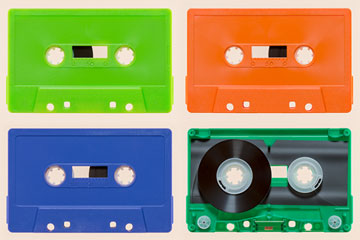
The man who invented the compact cassette tape doesn't remember what was recorded on the very first one, but he does remember what came next. Lou Ottens, who led the product's development for Philips, recalls the commotion that occurred when the Dutch company introduced the cassette to the world 50 years ago this month at a 1963 radio exhibition, the Funkausstellung in Berlin.
"It was a big surprise for the market," Ottens, now 87, says. "It was so small in comparison with reel-to-reel recorders that it was at that moment a sensation."
What now seems like a relic was a revolution in a plastic case. Keith Richards has said he wrote "Satisfaction" in his sleep using the tape recorder by his bed, which was the only way he remembered it in the morning. Tapes of Grateful Dead gigs are their own subculture. Cassettes let underground bands spread punk and DJs disseminate hip-hop. And it wasn't just music: we listened to books on tape, to recorded notes-to-self and to the hiss in the silence between tracks, not to mention the mechanical whir of fast-forward and the alveolar click that says Turn the tape over, hit play once more. Plenty of people, even now, are still listening.
From the beginning, the tape had a lot going for it. Reel-to-reel technology wasn't user-friendly: the reel tape was exposed and easily damaged; the machines were big; threading a tape from one reel to another was labor-intensive. Ottens' aim was to "make it smaller, make it cheaper and make it easier to handle." His tape was about half the width of the previous standard and protected by the cassette cartridge. The whole thing was, as a Philips press release pointed out, smaller than a pack of cigarettes.
The technology spread quickly. By the end of the '60s, tapes could be played in cars. National Audio Co. in Springfield, Mo.--the nation's largest producer of cassettes today--began selling the product. Current president Steve Stepp, who founded the company with his father in 1969, was confused the first time a sales rep brought one in. Used to 10-in. metal tape reels, he thought the cassette was a toy. Now his company churns out an average of 100,000 of them every day. "We're probably selling more audiocassettes than we've ever sold right now," Stepp says.
Sure, some of National Audio Co.'s success with cassettes is due to lack of competition. (Philips, for example, no longer makes them.) But that's not all, says Stepp. Tapes are cheap. Anyone can record anything on them. They have retro appeal and an appealingly analog sound. They're durable and portable.
The numbers confirm Stepp's observations. In 1993, Nielsen SoundScan found rough parity between the CD and the cassette. Although sales of the latter have declined, 200,000 albums sold on tape in the U.S. in 2012--a fraction of a percent of the 316 million total albums sold but a 645% increase over 2011 cassette sales. David Bakula of Nielsen's entertainment division says the tape's advantages (affordability, portability, recordability) keep it alive.
